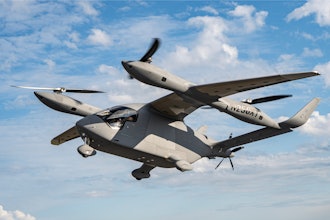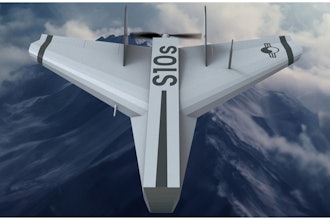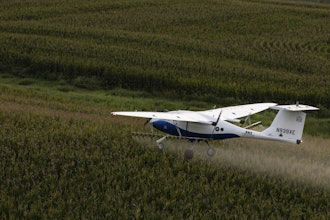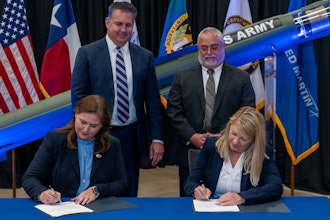Crop dusters keep Iowa's farm fields and the economy healthy.
The saying "pennies from heaven" certainly doesn't refer to aerial spraying. Ag aviation contributes $214 million to the state's economy because of increased crop productivity, according to a study released last year by the Iowa Department of Transportation's Office of Aviation.
That's not all.
Eighty-six percent of Iowa's general aviation airports support crop dusters, the report said. Those small airfields contribute more than $400 million to the state's economy.
Despite the positive financial aspects, agriculture aviation officials say the industry has had its fair share of negative publicity this summer. There's been several reports in the region of plane and helicopter crashes and pilots accidentally spraying people.
Officials involved with ag aviation — owners, state experts and farmers — want the public to understand how valuable crop dusters are to the state and that safety is a top priority.
"One accident is too many," said Tim McClung, planning and outreach manager for the DOT's Office of Aviation. "At the same time, we need to keep it in perspective. There's 4 million acres treated by air in Iowa every year. That works out to about 26,000 annual missions."
Farmers often rely on planes and helicopters to apply chemicals to control yield-robbing diseases and pests once plants get too big for ground rigs. Starting in early July, pilots typically have a little more than two months to get the job done.
DOT data show there's 50 aerial spraying companies in the state. An estimated 150 to 200 out-of-state outfits also stay busy here.
Considering the amount of ground that's covered in a relatively short amount of time, McClung said crop dusters do a good job.
McClung, who also is a pilot, said crop dusting is a difficult, sometimes-dangerous job. Aircraft swoop in to spray only feet off the ground. Pilots need to avoid electrical lines, trees, wind turbines and make sure chemicals land on target.
"They've really been pushing a culture of safety," McClung said.
At Hoppe Airspray near Beaman, co-owner Roy Sharp said every precaution is taken to protect pilots and the public. Hoppe's four planes are outfitted with global positioning system technology. One employee's job is keep track of where detasselers are working — some were sprayed in Grundy County in July by a different company — and areas that can't get sprayed, like organic crops, land with commercial bee hives and fruit and vegetable plots.
The Iowa Agricultural Aviation Association helped companies control drift problems, which Hoppe participated in, prior to the season. Crop dusters flew to Newton and filled aircraft with dyed water and "crop dusted" a simulated field. The exercise provided data to fine-tune equipment and gave pilots valuable practice knowing when nozzles need to be shut off.
"It gives us peace of mind we're doing a good job," Sharp said. "Pilots are very aware of where chemicals will be by the time they hit the ground."
Sharp said Hoppe has been incident-free since purchasing the company two years ago with Dan and Jeannie Tonner.
Farmers say crop dusters play a vital role in grain production.
This summer's hot, humid and wet conditions spurred fungus growth in corn. Some disease issues also cropped up in soybeans, and soybean aphids — though not at disastrous levels yet — are starting to become a problem. Insects in seed corn still need to be managed, as well.
Driving sprayers through fields at this time, or in July for that matter, would cause too much damage and be counterproductive. Aerial application of fungicides and insecticides is the only answer.
On average, officials said crop dusting costs between $15 to $25 per acre. Spraying corn fungicide, for example, is on the top end of the scale.
Dave Hommel of rural Eldora had 650 acres of corn and 200 acres of soybeans sprayed.
"That will be a good move," Hommel said. "We'll see the benefits. I noticed leaf areas cleaned up after (spraying)."
If left unchecked, fungus will disrupt plant development and interrupt photosynthesis. In corn, ears won't fill out properly and yields will suffer.
Farmers and crop experts say crop dusting usually pays for itself and then some.
It's not uncommon to see a 10- to 30-bushel yield response in corn. A soybean field infested with aphids mean yield reductions of 20 bushels or more per acre come harvest.
Recent cash corn at the East Central Iowa Cooperative in Hudson was $3.38 per bushel, while beans were $9.91.
"There's that much more money going to be circulating out there," McClung said.
Besides the monetary benefit, farmers also like the immediacy of aerial spraying. One plane can cover 1,000 to 2,000 acres a day, Sharp said.
"Historically, (aerial spraying) is good, but results always vary by year," said Tim Burrack, a grain farmer near Arlington and member of the Iowa Corn Promotion Board.
There wasn't a shortage of work this year, Sharp said.
"Farmers realize the benefit," he said.
___
Information from: Waterloo-Cedar Falls Courier, http://www.wcfcourier.com


















